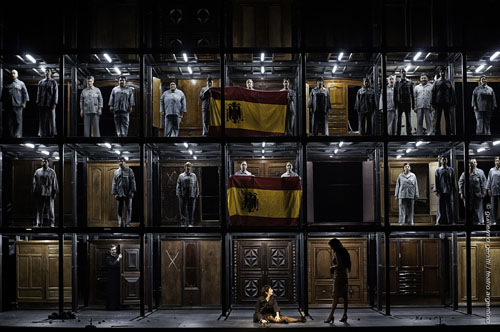 Argentina Albéniz, Pepita Jiménez: Soloists, Orchestra, Chorus and Children’s Chorus of Teatro Argentino. Conductor: Manuel Coves, Teatro Argentino, La Plata. 28.10.2012. (JSJ)
Argentina Albéniz, Pepita Jiménez: Soloists, Orchestra, Chorus and Children’s Chorus of Teatro Argentino. Conductor: Manuel Coves, Teatro Argentino, La Plata. 28.10.2012. (JSJ)
Director: Calixto Bieito
Sets: Rebecca Ringst
Costumes: Ingo Krügler
Lighting: Carlos Márquez
Chorus: Miguel Martínez
Children’s chorus: Mónica Dagorret
Cast:
Pepita Jiménez: Nicola Beller Carbone
Luis de Vargas: Enrique Ferrer
Antoñona: Adriana Mastrángelo
Pedro de Vargas: Gustavo Gibert
Vicar: Victor Castells / José Antonio García
Count Genazahar: Sebastián Angulegui
First official: Francisco Bugallo
Second official: Juan Pablo Labourdette

Of Albéniz’s operas, Pepita Jiménez seems to be the one on which most attention has been lavished, with Albéniz himself producing three different versions, and several revisions appearing subsequently. For the American premiere of the work at the Teatro Argentino, in a co-production with the Teatros del Canal (where it will be given in May 2013), another revision has been prepared, this by Borja Mariño using Albéniz’s second (1896) so called Prague version – in essence, the work in its original English in two acts running continuously, with a runtime of just 95 minutes.
Pepita Jiménez is based on the novel of the same name by Juan Valera and tells of the wealthy 19-year old Andalucian widow, who after the death of her 80-year old husband Uncle Gumersindo and having inherited his fortune, is being courted by various suitors including the playboy Count Genazahar and the middle aged Pedro de Vargas. Pepita herself is in love with the latter’s son Luis, who is training to enter the church and about to leave the village, but as she grows increasingly desperate, her maid Antoñona is planning to bring them together, which she finally does just as Pepita is on the brink of suicide.
Calixto Bieito’s approach to what is ultimately a rather weak storyline is the bizarre and shocking, with a basic dark and heavy set (from German scenographer Rebecca Ringst) with a series of wardrobes suggesting different locations. Sexuality is also important, though there doesn’t appear to be anything to suggest it in the text, and while Pepita given her situation may well be sexually frustrated, it was Antoñona who pleasured herself during Pepita’s confession and later a chorister likewise sitting on the vicar’s lap, all culminating in a harshly lit nude Virgin (attracting a wolf whistle from one wag). Hence the program note about some scenes possibly affecting the sensibilities of viewers and restricting entry of up to 16-year-olds only with an accompanying adult.
Nicola Beller Carbone made the most of Pepita, injecting as much drama and intensity into the role as she could, as too did Adriana Mastrángelo as a young and attractive rather than elderly Antoñona, although her voice couldn’t cope with the lowest parts of her role. Spanish tenor Enrique Ferrer was a sensitive Luis and Gustavo Gibert well portrayed the lecherous father but his voice went off shortly into the production. Victor Castells was an expressive vicar (for opening night only) and Sebastián Angulegui was a brash Genazahar, while Francisco Bugallo and Juan Pablo Labourdette also well filled their respective roles as the two officials.
Spanish conductor Manuel Coves seemed comfortable with Albéniz’s score varying from dense textures to the lighter shades of Sullivan (with whose music Albéniz would have been familiar, as he lived for several years in London). However, frequently the music was overloud against the singers. The chorus, dressed like prisoners, sung well in their one big scene and the children’s chorus were also faultless.
Jonathan Spencer Jones